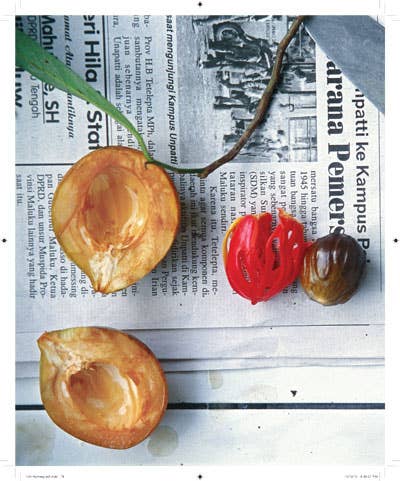
I saw my first nutmeg tree in Trinidad, from the window of a moving car. I immediately told my boyfriend, who was driving, to hit the brakes. The tree was spectacular, maybe 20 feet tall, with a canopy of glossy leaves and a riot of pale-yellow fruits bending the branches. More of those fruits lay all over the ground, and most of them had burst open to reveal a seed the size of a walnut, encased in a web of red fibers. Our friend Nigel, who grew up on the island, was with us, and he laughed as I snatched up one of the fruits and held it to my nose. "It's nutmeg," he said. Suddenly I understood that the musky jam I'd eaten at breakfast that morning wasn't spiced with nutmeg; it was made of it.From that moment on I noticed nutmeg trees all over that part of the island, and nutmeg in everything I ate and drank. It was the high note in the sweet potato cake called pone, and the earthy counterpoint to the Scotch bonnet chiles in a soup of beef, taro, and yam. Tasting the island's spicy, custardy version of macaroni and cheese, I realized I'd been eating nutmeg in cheesy, eggy, and creamy dishes all my life; it was both familiar and a total mystery to me.
Aptly dubbed Myristica fragrances ("musky scent") by some long-ago botanist, nutmeg grows on a number of islands in the Caribbean—Trinidad's neighbor Grenada, which until recently produced 20 percent of the world's supply, proudly displays nutmeg on its flag—yet it's a relatively new arrival to that part of the world. The tree is indigenous to the Banda Islands in what is today the Indonesian province of Maluku, also know as the Moluccas Islands, and Indonesia still produces the majority of the world's nutmeg. For millennia it grew only in Banda, which made the two spices it produces—nutmeg, the seed's kernel, and mace (see "Nutmeg's Other Half,", the red web covering it—a rare and hard-won commodity. Nutmeg arrived fashionably late to the European table—after the turn of the 11th century, far later than, say, pepper or cardamom—and its novelty only intensified its allure.
Along the medieval spice route, every time nutmeg changed hands—from Bandanese producers to Arab traders, from Byzantine spice merchants to Venetian ones—somebody profited, and nutmeg's price increased exponentially. In the late 16th and early 17th centuries, when physicians began prescribing nutmeg as a cure for the plague, the price spiked even higher—one small sack of nutmeg represented enough capital to purchase a house in London and a servant, too—and the newly formed Dutch and English East India companies waged a ruthless struggle for control of the Moluccas. The Dutch prevailed, at least for a time. An 18th-century French adventurer named Pierre Poivre is credited with breaking the Dutch monopoly by smuggling seedlings out of the Moluccas and replanting them on the island of Mauritius, and as nutmeg plantations proliferated in Sri Lanka, Zanzibar, and the West Indies, the price of the spice plummeted.
At the same time, highly spiced dishes, the ultimate status symbol during the medieval period, were falling out of vogue across Europe, though nutmeg retained a certain cachet in part because of its narcotic properties. Myristicin, the chemical compound that gives nutmeg much of its pungency, also produces euphoria and even hallucinations at high doses, and the spice was used recreationally. Grated liberally over the punch served up by the gallon in 18th- and early-19th-century England, nutmeg was blamed for some of the most outrageous behavior associated with that potent drink. Lord Byron used the spice recreationally, as did Malcolm X, a century and a half later, while doing time in a Massachusetts prison. "Stirred into a glass of cold water," he recalled, "a penny matchbox full of nutmeg had the kick of three or four reefers."
These days, nutmeg's reputation is a lot more wholesome. There are those who wait until Christmas to haul out the tin of nutmeg powder and shake it over eggnog. In fact, most of us consume more nutmeg than we realize, in everything from quiche Lorraine to Coca-Cola. I asked John Wright, a flavorist who's created essences for firms like New York—based International Flavors & Fragrances for more than 40 years, what accounts for the spice's enduring popularity. "Nutmeg has a long history of use in food destined for young children," he told me. "At that age the brain is forming most of its connections, and nutmeg becomes hardwired as a permanent preference. One weapon in the arsenal of a wily flavorist is the addition of just a trace of nutmeg oil to the most unlikely flavors." Nutmeg, for instance, is typically used in the creation of berry flavors.
That's how I like to use nutmeg in the kitchen: in an almost subliminal way. It can overwhelm if used in excess, but nutmeg has a remarkable capacity to enhance other flavors. It's best known as a baking ingredient in cakes, pies, and cookies. In a British custard tart, nutmeg's subtle floral qualities come to the fore thanks to a dash of fragrant vanilla. While its flavor blooms in buttery sweets, the spice also thrives in savory foods. In Italy, nutmeg is used to take the metallic edge off of leafy greens, in dishes like the ricotta-and-spinach dumplings called malfatti. I love the version that Anna Klinger makes at the restaurant Al Di La, in Brooklyn, New York. She uses Swiss chard in place of spinach, and its sweetness echoes that of the nutmeg she grates in.
It's in drinks, above all, that nutmeg still retains some of its former exoticism. Jane Danger, a bartender at the bar Cienfuegos in Manhattan, uses nutmeg in her Cayo Romano rum cocktail, to round out the heat of ginger liqueur. "I always grate it fresh," she says; nutmeg's oils are highly volatile, so the preground stuff loses its verve pretty quickly. The Cayo Romano is an update on the rum punches still served with a generous sprinkling of nutmeg throughout the Caribbean, a potent reminder that both rum and nutmeg once fueled the building of empires.
Keep Reading
Continue to Next Story










